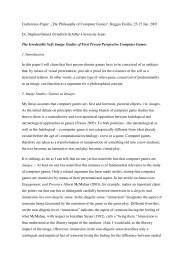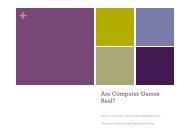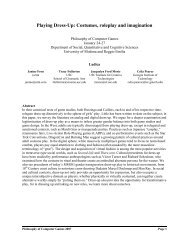Charles Sanders Peirce and the Mind-Body-World Relation
Charles Sanders Peirce and the Mind-Body-World Relation
Charles Sanders Peirce and the Mind-Body-World Relation
Create successful ePaper yourself
Turn your PDF publications into a flip-book with our unique Google optimized e-Paper software.
contexts of everyday use <strong>and</strong> application of artefacts in scientific enquiry <strong>and</strong>application, <strong>and</strong> also, of course, to some extent in educational settings in whichscience, ma<strong>the</strong>matics, arts, economics, <strong>and</strong> psychological <strong>and</strong> o<strong>the</strong>r socio-culturalsubject matter are central actors. And most certainly, an efficacious <strong>and</strong> unhinderedcommunicational sharing <strong>and</strong> discussion of <strong>the</strong>oretical <strong>and</strong> field-based experimentalsubject matter with o<strong>the</strong>r inquirers involved in <strong>the</strong> same field is of quite fundamentalimportance in order for any area of science, pure or applied, as it is for education, toprogress <strong>and</strong> develop in a satisfactory way.It is important to consider that today <strong>the</strong>re is an increasing flora of new tools <strong>and</strong>media for <strong>the</strong> (re)mediation (see Bolter & Grusin, 1999) <strong>and</strong> sharing of scientificsubject matter, all of which largely involve <strong>the</strong> use of new technologies forrepresentation <strong>and</strong> communication. We only need to think of <strong>the</strong> multifarious(re)presentational possibilities offered by fixed <strong>and</strong> mobile digital technologies of allkinds, ranging from fast distributed network computer systems, <strong>and</strong> <strong>the</strong> world wideweb to mobile telephones <strong>and</strong> increasingly small <strong>and</strong> more powerful portablecomputers with a potential for Internet <strong>and</strong> wireless-based peer-to-peer forms ofconnectivity. In addition to this, <strong>the</strong>re is also an increasing degree of technologicalconvergence between traditional forms of media <strong>and</strong> newer media based on digitaltechnologies, <strong>and</strong> this hybridisation is also becoming evident in terms of <strong>the</strong> variousmeaning types <strong>and</strong> tokens that <strong>the</strong>se converging media create, mediate <strong>and</strong>communicate, as well as <strong>the</strong> ways in which this creation, mediation <strong>and</strong>communication is carried on, where, when <strong>and</strong> by whom.These ongoing technological <strong>and</strong> associated sociocultural developments, toge<strong>the</strong>rwith <strong>the</strong> opening up of traditional boundaries between pure <strong>and</strong> applied science <strong>and</strong>between science <strong>the</strong> rest of society <strong>and</strong> culture (also seen in local-global terms), meanthat conventional forms of life in <strong>the</strong> scientific communities <strong>and</strong> traditions Ransdell isreferring to above are becoming increasingly intermingled with emergent forms of lifein a complex dynamic relational space involving scientific research <strong>and</strong> application –for example in financial, business <strong>and</strong> cultural contexts <strong>and</strong> in various kinds ofeducational <strong>and</strong> vocational training environments – in complex interactions withartefacts of <strong>the</strong> “external mind” type in <strong>the</strong> guise of <strong>the</strong> various “species” of AI <strong>and</strong> IAtechnologies referred to by Skagestad above.It is reasonable to assume that many “first encounters” with <strong>the</strong>se new aspects of <strong>the</strong>broader “ecological niche” in <strong>the</strong> flow of cultural <strong>and</strong> social communicationtraditionally occupied by scientific communities (which are now being forced to openup <strong>the</strong>ir professional discourses in order to take account of o<strong>the</strong>r voices <strong>and</strong>perspectives, not all of which belong to active participants in scientific <strong>and</strong>technological development processes, but who are ever more concerned to evaluate<strong>and</strong> dispute publicly, <strong>the</strong>ir potential value, <strong>and</strong> <strong>the</strong>ir uses <strong>and</strong> disuses), will take <strong>the</strong>form of “surprising events”.For many different people in all areas of society, <strong>the</strong>n, our day-to-day encounters wi<strong>the</strong>mergent technologies of mind, <strong>and</strong> <strong>the</strong> new, evolving forms of life that go toge<strong>the</strong>rwith <strong>the</strong>se technologies, <strong>and</strong> which <strong>the</strong>se technologies suggest <strong>and</strong> support, will createtypes of non-ordinary experience that we can calculate will assume, at least for awhile, <strong>the</strong> role of <strong>Peirce</strong>’s “Strange Intruder”. Quite some time <strong>and</strong> effort on <strong>the</strong> partof each of us as individuals, as well as <strong>the</strong> wider communities that we belong to, willbe necessary in order to assimilate <strong>and</strong> integrate <strong>the</strong>se experiences successfully intoour present forms of life, <strong>and</strong> in ways that can benefit us, <strong>and</strong> <strong>the</strong> rest of <strong>the</strong> organismswe share this planet with, in <strong>the</strong> longer run of things. In <strong>the</strong> course of this process<strong>the</strong>se new forms of life will come to embody new <strong>and</strong> highly dynamic genres of






